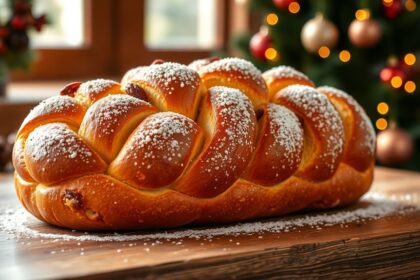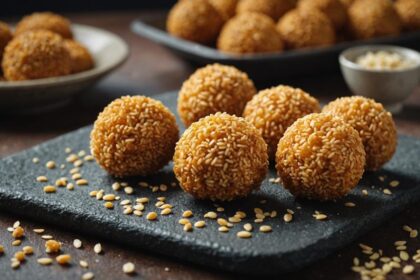Get into the holiday spirit with a Traditional Julekage Recipe, a cherished Scandinavian Christmas bread filled with candied fruits, nuts, and warm spices. Mix the dough with fruits, let it rise, then bake to a golden perfection. With tips on kneading, rising, and adding toppings like almonds, your Julekage will be a festive delight. Serve warm with butter, jam, or cheese for a cozy treat. This recipe provides the perfect way to bring a taste of Nordic tradition to your holiday table, ensuring a heartwarming and flavorful experience with each bite.
Julekage Recipe Overview
Indulge in the festive flavors and traditions of the holiday season with this delectable Julekage Recipe Overview. Julekage, a traditional Scandinavian Christmas bread, is enriched with candied fruits, nuts, and warm spices. The dough is mixed with candied fruits and left to rise in a warm place, allowing the flavors to meld beautifully.
Traditionally served at Christmas, Julekage is a beloved treat in Norway and other Scandinavian countries. The bread can be frosted with a sweet icing, adding an extra touch of sweetness to the already flavorful loaf.
Shaped into loaves for sharing, Julekage is perfect for gatherings and celebrations during the festive season. Once baked, the bread fills your home with the delightful aroma of Christmas spices.
Enjoy Julekage sliced and toasted, paired with butter or jam for a heartwarming holiday indulgence. The combination of candied fruits, nuts, and spices in this Christmas bread creates a truly special treat for the season.
Baking Tips for Julekage
For best results when making Julekage, consider using a stand mixer for the wet and sticky dough. This will make kneading easier and guarantee a well-mixed dough.
The rising time of your Julekage may vary depending on the temperature of your kitchen, so be patient and let it rise until doubled in size. When shaping the dough, grease the work surface with oil instead of flour to prevent sticking. This will make handling the sticky dough much simpler.
To add extra flavor and texture to your Julekage, consider plumping up the raisins by soaking them in rum or boiling water before incorporating them into the dough. Additionally, for a decorative touch, you can sprinkle optional toppings like flaked almonds or pearl sugar on top before baking.
These toppings not only add visual appeal but also provide a delightful crunch and sweetness to your Julekage.
Key Ingredients for Julekage
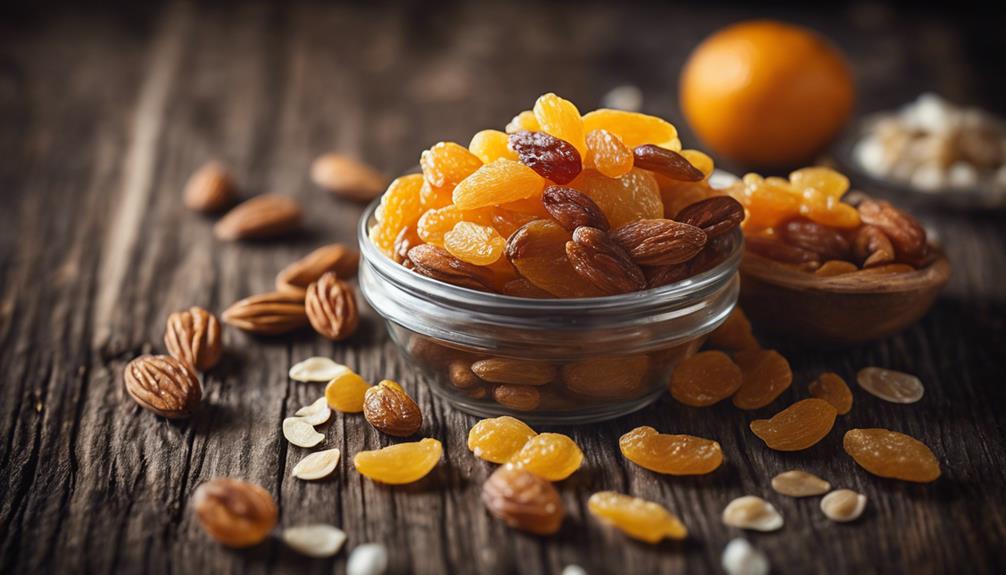
You should know the essential ingredients that make up a traditional julekage. Flour, sugar, butter, yeast, and a variety of dried fruits are key components in creating this festive bread.
Don't forget about the warming spices like cardamom, cinnamon, or nutmeg to infuse your julekage with rich flavors.
Julekake Baking Tips
Consider incorporating a variety of key ingredients such as flour, yeast, raisins, candied fruit, warm milk, salt, cardamom, sugar, egg, and butter for a delicious Julekake baking experience.
When preparing the dough, using a stand mixer with a dough hook can help handle the wet and sticky consistency more easily. After adding the ingredients, make sure to knead the dough until it becomes smooth and elastic.
When shaping the dough, you can add soaked raisins for extra flavor and texture. To enhance the visual appeal, consider adding optional toppings like flaked almonds or pearl sugar before baking. These toppings can also provide a delightful crunch to each bite of the Julekake.
Once baked to perfection, serve the Julekake warm with butter, jam, cheese, or smoked meats for a traditional holiday treat that will surely impress your guests.
Essential Julekake Ingredients
To create a flavorful Julekage, start by gathering essential ingredients like dried fruits, dark rum, milk, yeast, flour, salt, cardamom, sugar, egg, and butter.
Dried fruits such as raisins and candied citrus are key components that add sweetness and texture to the Julekage. Before incorporating them into the dough, it's common to soak the dried fruits in dark rum to plump them up and infuse them with flavor.
When ready to bake, warm milk is often used to activate the yeast, helping the dough rise in a warm and cozy environment. Once the Julekage is shaped and placed in the pan, a final touch of egg wash can be applied to give it a shiny, golden crust.
Sprinkling candied citrus on top not only adds a pop of color but also enhances the overall taste of this festive bread.
Steps to Make Julekage
To make Julekage, start by dissolving yeast in warm water to activate it.
Then, combine flour, sugar, butter, milk, spices, and candied fruits to form the dough.
Julekake Baking Techniques
Before adding plump raisins and candied peel to the dough for extra moisture and flavor, it's recommended to soak them in rum or boiling water.
To start making Norwegian Christmas Bread, proof the active dry yeast in warm milk until frothy. Combine the dry ingredients of flour, salt, and cardamom in one bowl and mix the wet ingredients like sugar, egg, and milk in another.
Once the yeast is activated, blend the wet and dry mixtures together, then knead the dough until it becomes smooth and elastic.
Next, fold in the soaked fruits for a burst of sweetness in every bite. Shape the dough into a round loaf, cover it, and let it rise until doubled in size.
After it has risen, glaze the Julekage with an egg wash before baking it until golden brown.
Once baked, let the Julekake cool completely before slicing into it to savor the delicious flavors within.
Key Ingredients for Julekage
Soak the dried fruits in rum or boiling water to plump them before incorporating them into the dough for your traditional Julekage recipe. Julekake, popular in Norway, features ingredients like plumping raisins, red and green cherries, and a milk mixture.
These components, along with cardamom and candied citrus peel, create a flavorful bread. Once the dried fruits are ready, mix them into a smooth and elastic dough. Let the dough rise until it doubles in size, allowing the flavors to meld together.
Shaping the dough into loaves and brushing them with an egg wash gives the Julekage its golden-brown finish. Baking the loaves until they're cooked through guarantees a tender texture.
The combination of plumped raisins, cherries, and the aromatic spices in the bread make Julekage a delightful treat for the holiday season.
Serving and Storing Julekage
When serving Julekage, consider pairing it with butter, jam, cheese, or smoked meats for a festive culinary experience.
To store your Julekage, wrap the loaves in foil or place them in a plastic bag at room temperature for a few days. If you prefer to keep it for longer, freeze the Julekage loaves and let them thaw at room temperature when you're ready to enjoy them.
Slicing the Julekage and toasting it before serving can enhance its flavors, making each bite even more delightful.
This traditional holiday bread is perfect for enjoying with a variety of spreads and preserves, adding a touch of sweetness or savory goodness to your meal.
Whether you choose to serve it warm or toasted, Julekage is sure to bring a taste of holiday cheer to your table.
Baking and Serving Julekage
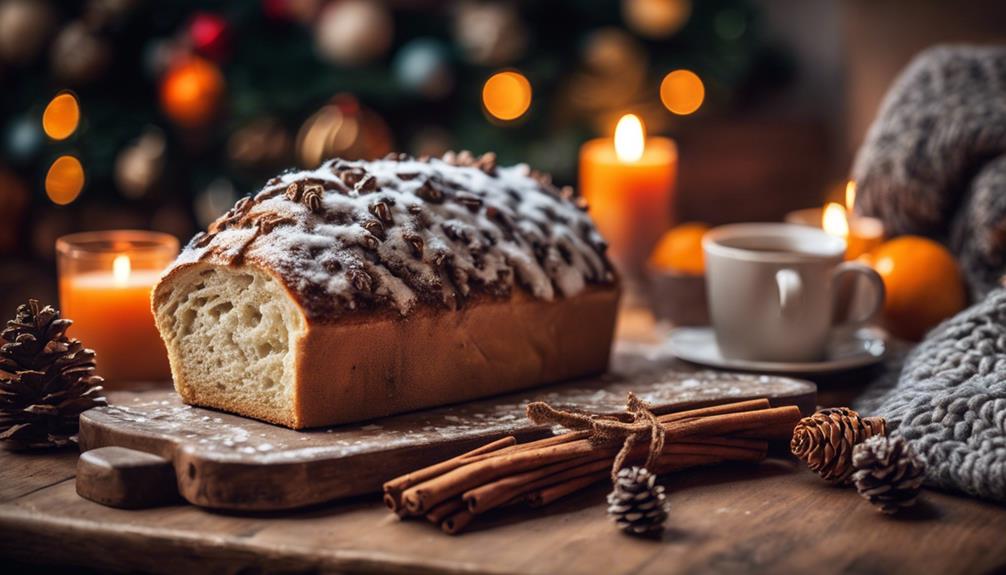
To bake and serve Julekage, shape the dough into a loaf before letting it rise for the second time. After placing it on a lightly floured work surface, apply an egg wash for a glossy glaze.
Once prepared, bake the Julekage until it reaches a beautiful golden brown color in the oven. Remember to allow it ample time to cool before slicing into it.
When serving, consider pairing the Julekage with a spread of butter, jam, or cheese for a delightful treat. To enhance the experience further, brew a pot of hot tea or coffee to accompany this traditional holiday bread.
- The anticipation of the Julekage rising in the oven fills you with warmth and excitement.
- The golden brown crust exudes a comforting aroma, making your mouth water.
- Slicing into the cooled Julekage reveals a soft, flavorful interior that delights your senses.
Julekage Recipe Variations
Explore exciting Julekage recipe variations by incorporating different dried fruits, nuts, spices, or toppings to add a unique twist to this traditional holiday bread.
When experimenting with fruit variations, consider using a mix of raisins, apricots, cranberries, or even candied orange peel to enhance the Scandinavian bread's flavor.
For a nutty crunch, try adding almonds, pecans, or walnuts to the dough. To elevate the taste profile, sprinkle in a dash of cinnamon, nutmeg, or cardamom for a fragrant touch.
After baking, personalize your Julekage by drizzling cooled loaves with lemon or almond icing for extra sweetness. For a festive touch, consider incorporating rum-soaked fruits like cherries or figs into the mix or sprinkle pearl sugar on top for a delightful finish.
These variations won't only add depth to your Julekage but also make it a memorable treat for the holidays.
Storing Julekage
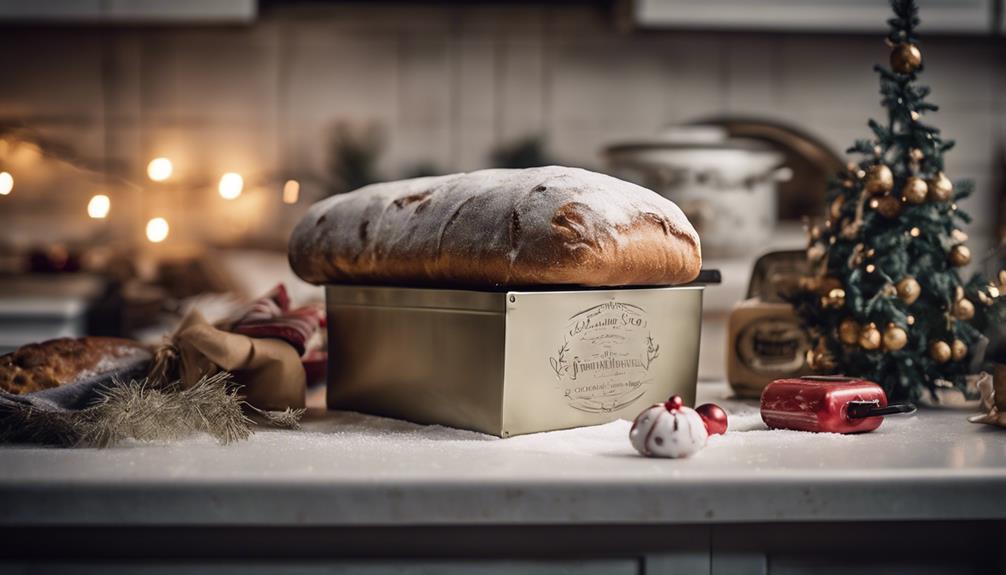
Proper storage is key to maintaining the freshness and flavor of your Julekage during the holiday season. To preserve your traditional Scandinavian bread stays delicious, consider the following storage tips:
- Room Temperature: Store your Julekage at room temperature for a few days to sustain its taste and texture.
- Plastic Bag or Foil: Wrap the Julekage in a plastic bag or foil to shield it from drying out while stored.
- Freezing Option: If you want to enjoy your Julekage later, freeze the loaves and then defrost them at room temperature when ready to eat.
Conclusion
Now that you've mastered the traditional julekage recipe, you can enjoy the holidays with a slice of warm, sweet bread that brings comfort and joy to all who taste it.
Just like the aroma of julekage baking in the oven fills your home with warmth, the flavors of this festive treat will fill your heart with happiness.
So grab a cup of coffee, gather your loved ones, and savor every bite of this delicious holiday tradition.




